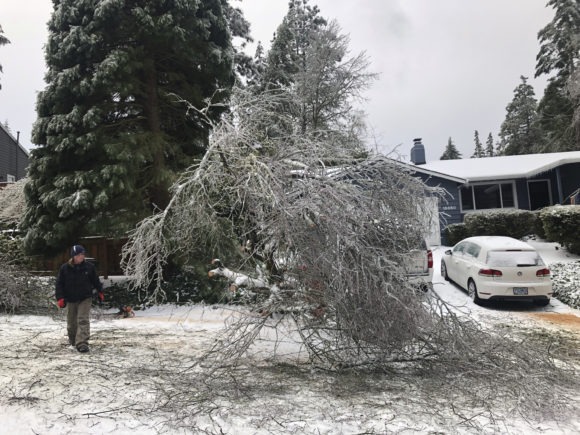LAKE OSWEGO, Ore. — At least 200,000 people remained without power in the Portland, Oregon, area Sunday after a winter storm blanketed the Pacific Northwest with ice and snow and made travel treacherous.
With a number of transmission lines and substations knocked out of service and additional tree limbs at risk of falling on power lines amid more expected freezing rain and wind, some people could experience multiple outages or prolonged outages, said Steve Corson, a spokesperson for PGE, one of the area’s major electricity providers.
“Our hope would be that most would be restored sooner than that, but some customers will be affected for several days,” he said.
The utility, which had about 250,000 customers without power on Saturday, is bringing in crews from Nevada and Montana to help restore power, he said. Other utilities, which reported about another 25,000 outages Saturday, were also working to bring electricity to homes and businesses.
Oregon Gov. Kate Brown praised utility crews as well as state and local workers and first responders for working to , clear roads and help those in need because of the extreme conditions, which prompted her to declare a state of emergency for the greater Portland area on Saturday. She urged everyone else to remain at home as much as possible.
“Check on your neighbors and loved ones when you can do so safely,” she said.
Forecasters warned of more hazardous weather through Monday.
An ice storm warning was in effect for the Portland area until Monday evening. In Seattle, which got more than a foot of snow by Sunday morning, more precipitation expected to fall as sleet or rain could cause snow-covered tree limbs to break, causing outages there, The Seattle Times reported.
Winter storms and extreme cold affected much of the U.S. West over the weekend, particularly endangering homeless communities. Volunteers and shelter staffers worked to ensure homeless residents in Casper, Wyoming while authorities in western Washington and western Oregon opened warming shelters in an effort to protect homeless residents from the wet and cold.
Arctic air caused temperatures to plunge to the negative 30s in parts of Montana and high temperatures were not expected to rise above zero or get much higher in eastern Wyoming or Colorado.
In the Portland area, many trees snapped under the weight of ice, falling on power lines and causing transformers to blow out in showers of blue and orange sparks.
Brian Zevenbergen watched Saturday as a crew sawed up two large, ice-covered trees that had crashed across his driveway overnight, narrowly missing two cars parked there. His house in Lake Owego had also lost power overnight. Just around the corner, another massive tree blocked the street in the suburb south of Portland and had taken out a city street light.
“Last night, everything was standing, and this morning the two trees had me blocked in the driveway and were blocking at least half the street,” he said. “Friends on the lower levels have power, so I have invites to go hang out there.”
The ice and snowfall caused treacherous driving conditions, forcing Oregon transportation officials to close Interstate 84 in the Columbia River Gorge, and the regional transit agency TriMet suspended all bus and train service in the region on Saturday. Eastbound lanes remained closed and limited buses and trains were running Sunday although TriMet urged people to delay travel until conditions improve.
The latest storm system was expected to bring snow to the mountains of the Northwest and the Intermountain West through Monday night.
The highest parts of the Cascades were expected to get snow measured in feet while over a foot of snow is likely in the Bitterroot Mountains of Idaho, the Teton Range in Wyoming and the central Rockies, the National Weather Service said.
–Boone reported from Boise, Idaho. AP journalist Colleen Slevin contributed to this report from Denver.
About the photo: People walk by a collapsed tree in Lake Oswego, Ore., Saturday, Feb. 13, 2021. The tree fell during an ice and snowstorm that left hundreds of thousands of people without power and disrupted travel across the Pacific Northwest region. (AP Photo/Gillian Flaccus)
Was this article valuable?
Here are more articles you may enjoy.


 Insurance Industry Contemplates Knock-On Effect of Tariffs to Claims, Consumers
Insurance Industry Contemplates Knock-On Effect of Tariffs to Claims, Consumers  ‘Everything Is on the Table’ in NYC Helicopter Probe, NTSB Says
‘Everything Is on the Table’ in NYC Helicopter Probe, NTSB Says  In Fight Over Insurance, Neighbors Crowdsource LA Fire Contamination Data
In Fight Over Insurance, Neighbors Crowdsource LA Fire Contamination Data  Nearly 24 Firms Seek Deal With CFTC to Settle Enforcement Cases
Nearly 24 Firms Seek Deal With CFTC to Settle Enforcement Cases 